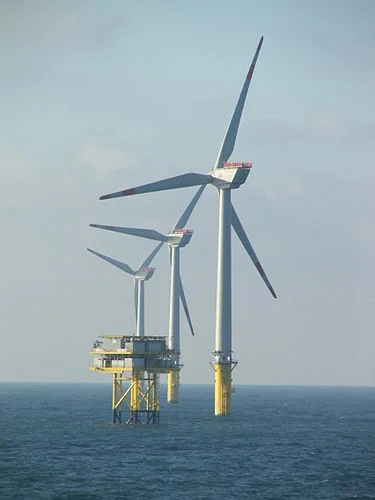
Tim Faulkner: Future looks bright for New England offshore windpower
Via ecoRI.org
The future looks promising for the local and regional offshore wind business. Three recent reports project up to 36,000 new jobs and 8,000 megawatts of offshore wind power between New Jersey and Maine by 2030.
Released by the Clean Energy States Alliance, a coalition of state energy agencies, the reports examine and aggregate information about offshore locations, state policies, interconnection infrastructure, and job potential.
The main findings identify 109 different occupations and electricity output for nearly 4 million homes. By comparison, Rhode Island has 462,000 housing units and Massachusetts 2.7 million.
Of the the seven states in the reports, Massachusetts has the greatest resources for offshore wind energy, with 82,704 megawatts of potential power. Maine is next with 56,503 megawatts, but currently has no wind projects proposed. Rhode Island has 8,364 megawatts of wind potential. Rhode Island and Massachusetts share a federally designated wind-lease area south of Martha’s Vineyard.
The reports are part of a regional effort to promote renewable-energy planning called A Roadmap for Multi-State Cooperation on Offshore Wind Development. They were partially funded by a U.S Department of Energy grant of $592,683 given to the New York State Energy Research Development Authority. The reports were also done for the Massachusetts Clean Energy Center, Massachusetts Department of Energy Resources, and the Rhode Island Office of Energy Resources (OER).
“As host to the nation's very first offshore wind farm, currently generating 30 megawatts off the southern coast of Block Island, we see these reports as key to laying the foundation for this growing industry,” OER administrator Carol Grant said. “The states in the region have individually taken important steps to advance offshore wind. The release of the new reports exemplifies how the states are also working together to advance offshore wind deployment and supply-chain development.”
Report one, the Northeast Offshore Wind Regional Market Characterization, looks at federal lease opportunities, state policies, regional energy needs, existing electricity generation and planned retirements, and transmission capacity through 2030.
Report two, U.S. Job Creation in Offshore Wind, looks at job potential. The majority of jobs are in project development and management, supply and installation of electrical substations and subsea cable, wind farm operation and maintenance, and possibly some in manufacturing.
Report three, U.S. Jones Act Compliant Offshore Wind Turbine Installation Vessel Study, examines the federal rule that requires all vessels transporting cargo between domestic ports to be built in the United States. The report concludes that the budding offshore wind industry would need a turbine installation vessel and a feeder barge. Shipyards have already been sent information on cost estimates. The installation vessel would cost about $222 million and some $87 million for the feeder barge.
Webinars on the reports are scheduled to held Nov. 20 and Dec. 7.
Tim Faulkner is on the staff of ecoRI News (ecori.org).
But how to store it?
About 10 percent of New England’s electrical power now comes from renewables and it’s growing at a good clip, mostly thanks to wind and solar power. That means less reliance on fossil fuel from outside the region, including the gas produced by fracking (that kind of drilling does poison some water supplies, by the way.)
The big problems in accelerating this push toward clean power are that the region’s 20th Century power grid is not set up well for the variability of electricity from solar and wind; it lacks large-scale ways to store electric power from such fluctuating sources.
If engineers and scientists can figure out how to efficiently store massive quantities of electric energy from renewables, aided by, for example, better forecasts of sunshine and wind, the region could finally become electricity-independent. Until then, we’ll have to take the natural gas that we can, despite the complaints of gas-pipeline NIMBYs who offer no plausible suggestions on how to keep the lights on and a functioning local economy without it.



